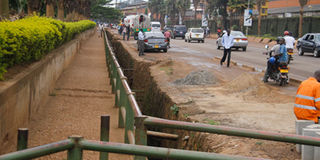Trees, open drainages a danger to road safety

Guardrails not only protect pedestrians but also prevent cars from crashing into the drainages incase of an accident. PHOTO by Abubaker Lubowa.
What you need to know:
There are several ways to make roads safe. Andrew Bagala writes about how guardrails can make this possible.
When Kampala Capital City Authority (KCCA) started a plan to reconstruct Kabaka Anjagala Road in Rubaga Division in Kampala, the first question was not about cost but to the trees on the sides.
Some argued that the trees gave a good shade to pedestrians and also protected them from danger in case there was an accident. Others cited environment and beauty among other reasons.
Officials from KCCA had to assure the dwellers that when they are done, they would plant young trees along the road. However, after completion of the road, KCCA did not plant the trees. May be this was a road safety idea.
Guardrails
Traffic safety specialists think otherwise. They say having open drainages or trenches as is the case on many highways like Bombo and Jinja Roads and trees along the road increase risks than they are intended to reduce.
Open drainages and lack of guardrails,has led to a number of accidents. For any mistake on the road, the motorist will be pushed into a drainage that will force the vehicle to roll or a tree that will act as an obstacle and increase impact of the crash.
Oz Mezer, a road traffic safety specialist in Germany, says trees along the roads increase impact to the crash and the harm to the occupants of a car in case of an accident.
Advantages
“If you have road guardrails and segregated highways, you will reduce accidents,” Mezer says.
Guardrails are metallic barriers often in the middle or at the side of the road that prevent or minimise impact when a motorist veers off the road.
They also protect pedestrians from direct danger of run off vehicle.
European Union safety standards state that having guardrails and barriers in the middle of highways protects vehicles coming from the opposite directions from head-on collisions.
South African road safety specialist Quinton Van Oudtshoorn, says in South Africa, they were faced with high cases of road accidents. They sensitised and enforced laws but the results were the same until they adopted the EU Safety Standards and accidents were dropped.
“Put a barrier in the middle of the road that separates vehicles coming from opposite directions. It is not cheap but it is possible. With standards, you will protect our people,” Oudtshoorn says.
Accident rates in Uganda
However, most roads in Uganda have no guardrails and the results are obvious in terms of pedestrian fatalities.
Annual Crime and Traffic Road Safety Report 2013, of the 2,937 accident fatalities, 1,181 were pedestrians in 2013. Many pedestrians were killed in urban areas where literacy levels on road manners are high but they are either knocked by vehicles that have veered off the road or motorists abusing walkways.
Nathan Tumushabe, the secretary, National Road Safety Council, says “lack of segregation has a big toll on pedestrians. If we had segregation on the road, the figures would be lower.”
Tumushabe says in countries where these safety precautions are put in place, accident deaths have dropped.
“In 2010, accident deaths in Uganda were 2,954 yet countries like Belgium and Sweden that have more vehicles on the road but are ensuring safety standards registered 840 and 266 accidents respectively,” he said.




